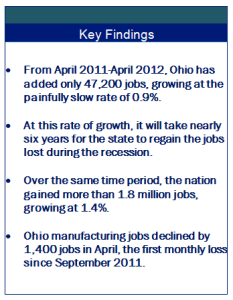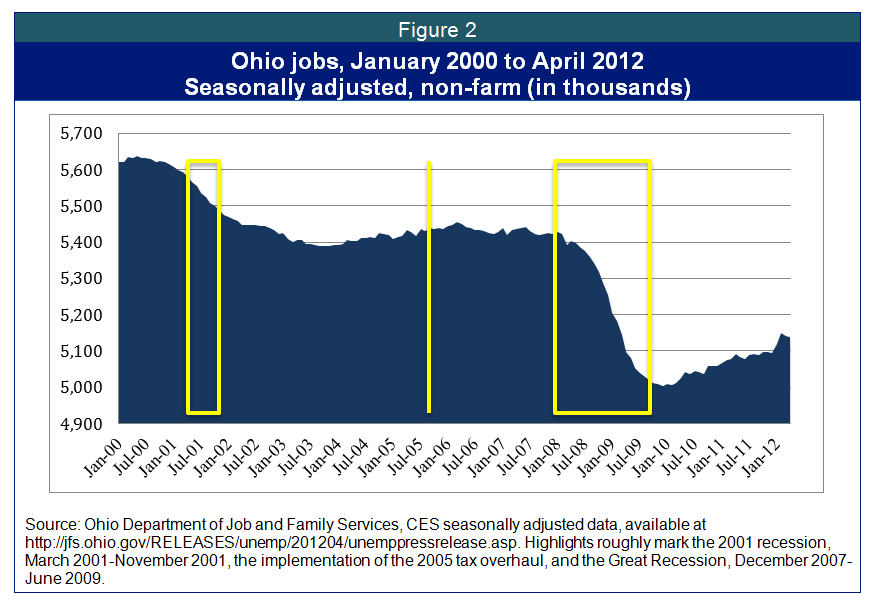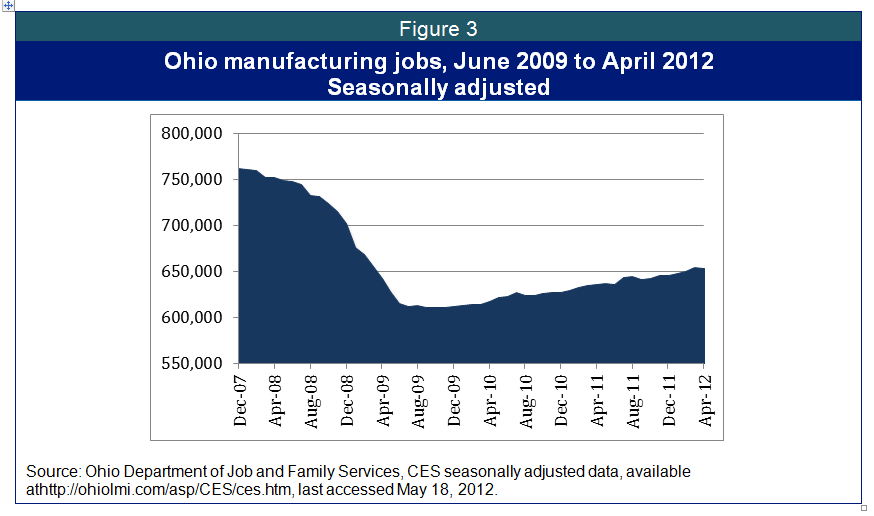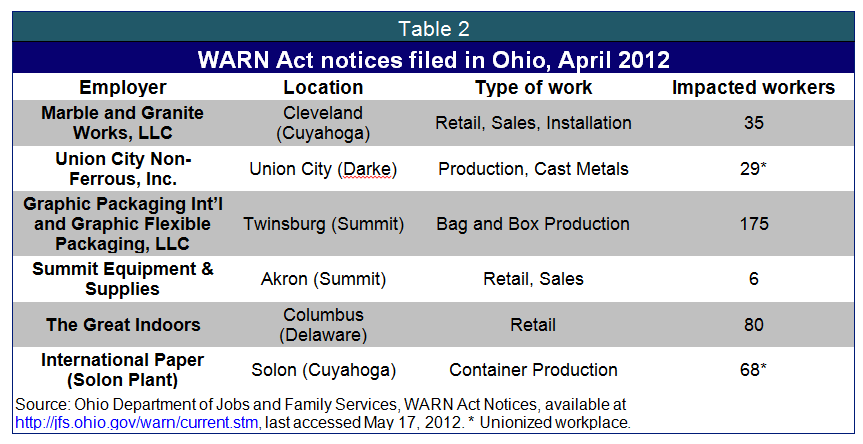
More mixed signals for Ohio’s job market in April
May 18, 2012
More mixed signals for Ohio’s job market in April
May 18, 2012
"Though the short-term picture remains cloudy, Ohio jobs will need to grow much faster to recover from the losses of the last two recessions.” Hannah Halbert, workforce researcher
Press releaseJob Watch May 2012
Data from two separate surveys released by the Ohio Department of Job and Family Services (ODJFS) today continue to portray a mixed picture of Ohio’s economy. The state’s unemployment rate continued to fall in April, landing at 7.4 percent according to seasonally adjusted data released from ODJFS’s survey of households for March 2012.  The household survey also showed that Ohio’s labor force grew by 6,000 individuals, which is good news for a state beleaguered by slow job growth.
The household survey also showed that Ohio’s labor force grew by 6,000 individuals, which is good news for a state beleaguered by slow job growth.
However, a separate survey of employers also released today by ODJFS showed that despite the positive news on the unemployment rate, Ohio lost jobs in March (5,200) and April (3,400). The surge in job gains earlier in the year appears to have come to an end. Month-to-month data is highly subject to revision, though, and it is ill advised to make too much of month-to-month comparisons, particularly when the surveys express mixed and contradictory messages.
There is more certainty in examining longer-term job trends. Even with the positive reports earlier this year, recovery in Ohio remains painfully slow. Since the official end of the great recession in June 2009, the state has had modest job growth of just 1.7 percent, with the addition of only 87,100 jobs. Since April 2011, the state job total has only grown by only 47,200, or 0.9 percent. Over the same period, the nation gained more than 1.8 million jobs, growing at 1.4 percent. At the rate of growth over the past 12 months, it will take nearly six years to generate the additional 282,500 jobs needed to return Ohio to pre-2007 recession levels of employment. That figure would be even higher if population growth were taken into account.
Figure 2 highlights changes in the Ohio job market from key points in time, including the start of the 2001 and 2007 recessions, and the 2005 approval of a major state tax overhaul, which promised speedier economic growth. These figures include the latest seasonally-adjusted data from the monthly survey of employers (Current Employer Survey) done by ODJFS in co-operation with the U.S. Bureau of Labor Statistics.
Table 1 details these changes. Not only is the state struggling to recover from the 2007 recession, Ohio never recovered from the 2001 recession, having lost more than 454,000 jobs since that recession began. Since the start of the 2007 recession, the state has lost 282,500 jobs.
Ohio could have improved its job outlook by maintaining public jobs. These jobs not only represent continued employment but also continued public services, keeping our neighborhoods safe and our communities healthy. Local public jobs have been hard hit since the recession ended. If Ohio had kept local public workers employed after the 2007 recession, more than 24,000 Ohioans would still be on the job.
As Figure 3 shows, the manufacturing sector has had steady but slow growth since the end of the 2007 recession. Manufacturing has been a bright spot in Ohio’s recovery not only because of consistent job gains but also because the sector has historically produced jobs with family sustaining wages and benefits. In April, the manufacturing sector posted its first job loss since September 2011, losing an estimated 1,400 jobs.
Recent WARN notices in Ohio
The Worker Adjustment Retraining Notification (WARN) Act protects workers and communities by requiring employers with more than 100 employees to provide 60 days advance notice of plant closures or mass layoffs. Federal, state, and local government entities are not covered. WARN triggers rapid response services, which can include layoff aversion, training and dislocated worker assistance. As Table 2 shows, six WARN Act notices were filed with ODJFS in April, impacting 393 workers, of whom 97 are in a union.
Conclusion
While today’s report presents conflicting data, one thing is clear: Ohio remains a long way from robust recovery. We need increased investment to restore our communities and grow good jobs.
JobWatch is an ongoing project of the Economic Policy Institute (http://www.epinet.org)
and Policy Matters Ohio, (http://www.policymattersohio.org).
Both are nonprofit policy research institutes.
Tags
2012Hannah HalbertJobWatchWork & WagesPhoto Gallery
1 of 22



